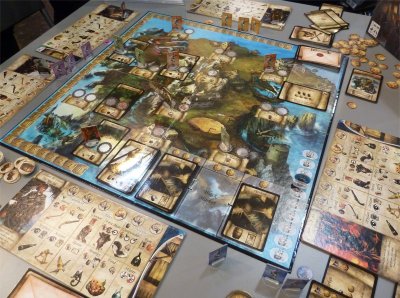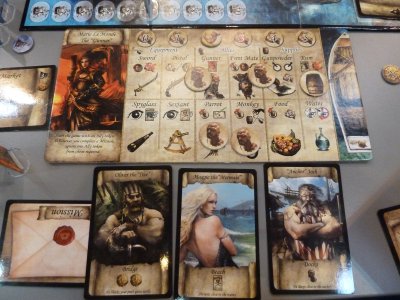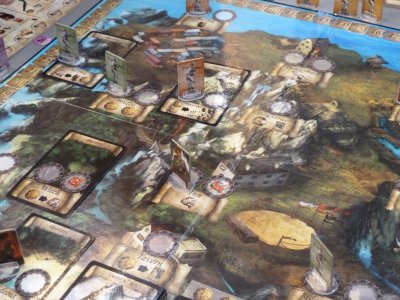

![[IMAGE]](../bilder/oathbro1.jpg) |
Designer: Publisher: No. of Players: |
![[IMAGE]](../technik/box/rot/rot-5.gif) ![[IMAGE]](../technik/box/gelb/gelb-9.gif) ![[IMAGE]](../technik/box/grun/grun-7.gif) ![[IMAGE]](../technik/box/pink/pink-6.gif) ![[IMAGE]](../technik/box/blau/blau-8.gif) |
|
Inside the gamebox which is decorated by a Pirate looking suspiciously similar to Jack Sparrow (hey, that's CAPTAIN Jack Sparrow - sorry) you will not not a worker but a Pirate placement game. When I had studied the rules ahead of the SPIEL '15 convention , I couldn't quite make up my mind what I should make of the game. Should I expect another relatively straightforward worker placement game, with the players just competing for resource spaces, using the resources later for fulfilling tasks assigned by the Pirate Brotherhood? Or are the different kinds of abilities available to the player's Captains, the quite interesting transition between resources and these abilities, and the possibility to discover new action locations actually hints at a game leaving the usual path? Well, all this had made me curious, and soon after starting our demo game I had to confess that the game and its considerable pace had captured my full attention.
As indicated, the players need to fulfil mission which they can get from the Brotherhood, and these missions usually consists of a combination of the three general types of resources (Equipment, Allies and Supplies) which must be delievered by the players to the Brotherhood building. Small amounts of these resourecs can be collected by the players at different locations on the board, and they can also be purchased at one location, the Black Market.
For acting on the board, each player has a figure for his Captain, and another 2 to 3 figures (depending on the number of players) representing his Mates. During a round, the players take turns to send their figures to free action spaces at the different locations, trying to interact with the places in order to gain resources etc.
 Whenever a player gains a resource, he has to place it on his player board, and that's the moment when things get interesting. Each kind of resources can be stored for up to five time's on a player's board, but onto one possibility to store a resource is a typical storage bay. The other four possibilities actually are four different kinds of improvements which correspond to the type of resource the player wants to store, and so a player can chose which type of improvement he wants to activate by placing the resource on the corresponding spot. E.g., if a player gains an equipment resource, he can place it onto a space depicting a Cutlass, a Pistol, a Spyglass or a Sextant, and as long as the resource is stored there the player will get the associated benefit. However, the Brotherhood missions usually require the delivery of more than one resource token per kind, and so the players often have to let some of their improvements go in order to fulfil a mission. The improvements or special abilities which the players can gain through the resources are quite variable, ranging from an extra movement of the Captain to the opening of an additional action space on an otherwise occupied location. Other pieces of equipment actually deal with the fact that a player coming to a location already occupied by another player's figure actually has to loose a Toughness point, and so the Cutlass can be used to prevent this loss, whereas a Pistol allows the player who has arrived earlier to decide whether the newcomer looses a Toughness point or has to pay 1 Doubloon. Quite interesting is also the use of a keg of Gunpowder, effectively emptying all Action spaces in an occupied location.  Apart from the board spaces dealing with the basic resources-to-missions "production chain", other locations give the players the possibility to gain additional Action cards or followers, piratish personalities which often give the players an advantage when dealing with a specific location. Especially the Action cards are really interesting, since they offer a wide range of one-time special effects, and they can also be combined to allow really interesting combinations of movement and actions. If combined with special abilities provided by resources, rather cool combos can be played, greatly enlarging the normal scope of one action per turn.
Quite surprisingly, even locations like the Watchtower which allows the discovery of new locations are used quite frequently during the game. I often play games with just two players, and before first playtesting I dounbted whether this location was that useful in a 2-player game, since the standard locations offer more than enough Action slots for two players. However, the Watchtower is also connected with the otherwise fixed role of first player, and so both players will visit the Tower more than once to gain the advantage of playing first in the following round. As a windfall effect, the visit to the Watchtower also triggered the appearance of new locations, and these offer a quite interesting choice of actions on their own, often connected with the spending and gaining of resources in different combinations.  To keep the game from getting too streamlined, both the Location and the follower deck usually will not be fully used up in a game of Oath of the Brotherhood, and so the players always have to adjust themselves to the different opportunities found in the game. As you might notice by my choice of words, the game certainly has surprised me as being much more entertaining than I suspected after reading the rules. Of course I knew that Vangelis Bagiartakis always comes up with some nice design ideas, but the way he combined some known mechanisms into the well-working design of Oath of the Brotherhood is really remarkable.Both thr high pace of the game and the always rather close rankings will keep the players fixed to their seats, and that's essentially all you need for starting your own career as a pirate! | ||
|
| ||

|
|

|
|
| ||
|
Impressum / Contact Info / Disclaimer Kulkmann@aol.com
Copyright & copy; 2015 Frank Schulte-Kulkmann, Essen, Germany | ||